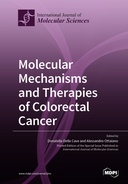Explore

Molecular Mechanisms and Therapies of Colorectal Cancer
0 Ungluers have
Faved this Work
Login to Fave
Colorectal cancer (CRC) is currently the third leading cause of cancer-related mortality, with 1.9 million incidence cases and 0.9 million deaths worldwide. The global number of new CRC cases is predicted to reach 3.2 million in 2040, based on the projection of aging, population growth, and human development.In clinics, despite advances of diagnosis and surgical procedures, 20% of the patients with CRC present with metastasis at the time of diagnosis, caused by residual tumor cells that have spread to distant organs prior to surgery, affecting the patient survival rate. Standard systemic chemotherapy, alternative therapies that target mechanisms involved in cancer progression and metastasis, immunotherapy, and combination therapies are the major CRC-treatment strategies. In the advanced stage of CRC the transforming growth factor-beta (TGF-β) plays an oncogenic role by promoting cancer cell proliferation, cancer cell self-renewal, epithelial-to-mesenchymal transition, invasion, tumor progression, metastatic spread, and immune escape. Furthermore, high levels of TGF-β1 confers poor prognosis and is associated with early recurrence after surgery, resistance to chemo- or immunotherapy, and shorter survival. Based on the body of experimental evidence indicating that TGF-β signaling has the potential to be a good therapeutic target in CRC, several anti-TGF-β drugs have been investigated in cancer clinical trials. Here, we presented a comprehensive collection of manuscripts regarding studies on targeting the TGF-β signaling in CRC to improve patient’s prognosis and personalized treatments.
This book is included in DOAB.
Why read this book? Have your say.
You must be logged in to comment.
Rights Information
Are you the author or publisher of this work? If so, you can claim it as yours by registering as an Unglue.it rights holder.Downloads
This work has been downloaded 92 times via unglue.it ebook links.
- 92 - pdf (CC BY) at Unglue.it.
Keywords
- 1,2-dimethylhydrazine
- Apc mutation
- barrier properties
- base excision repair
- biomarker
- biomarkers
- Breast cancer
- cell morphology
- Cell signaling
- ceRNA
- circRNA
- Clinical & internal medicine
- colitis-associated cancer
- colon
- colorectal cancer
- colorectal cancer initiation
- colorectal carcinoma
- colorectal liver metastases
- common fragile sites
- CTLA4
- Cytokines
- Diseases & disorders
- DNA damage repair
- DNA replication repair
- early onset CRC
- EMT
- epigenetics
- epithelial-to-mesenchymal transition
- FASN
- fatty acid synthase
- HAVCR2
- hepatic tissue-resident memory T cells
- heterogeneity
- HOX
- HOXB9
- hypoxia
- hypoxia-regulated microRNAs
- immune-suppressive
- immunology
- Inflammatory bowel diseases
- interleukin 10
- LARC
- Lipid Metabolism
- liver neoplasms
- liver regeneration
- lncRNA
- lymphovascular invasion
- Mass Spectrometry
- medicine
- metastasis
- metastatic colorectal cancer
- Methylation
- microRNA
- MiR-199b
- miRNA
- MMR
- multi-omics
- neoplasm metastasis
- Neurotensin
- neurotensin receptor-3
- noninvasive biomarkers
- Notch
- oncology
- perineural invasion
- phosphatidylinositol 3-kinase
- platinum therapy
- prognosis
- Proteomics
- rat
- S-adenosylmethionine
- soluble sortilin
- sortilin
- sponging
- stalled replication fork
- structural variants
- surgical oncology
- targeted sequencing
- targeting therapy
- TGF-β signaling
- tight junction proteins
- tumor necrosis factor alpha
- tumor suppressor
- tumor-associated macrophages
Links
DOI: 10.3390/books978-3-0365-6546-0Editions

